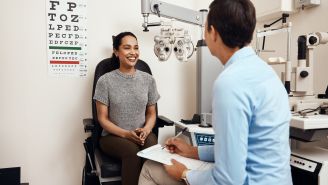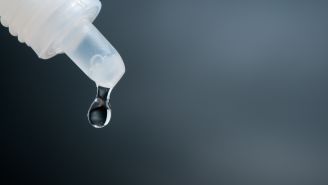Updated on November 16, 2023.
How often have you told your kids to crunch on carrots because they’re good for their eyes? Maybe you’ve scolded them for sitting too close to the TV, because it could hurt their vision. After all, that's what you heard growing up. But are those old nuggets of wisdom true?
The facts are a little more nuanced. Here are some of the most-asked questions about kids’ eye health, along with answers to help you now and in the years ahead.
Do children need eye exams?
Eye exams are crucial to your child’s overall health and development. Vision issues that aren’t caught and addressed affect not just their sight, but potentially their learning abilities. Often, vision problems start at a young age, so it’s critical to make sure your child gets the recommended vision screenings and comprehensive exams.
What’s the difference between screenings and exams?
Vision screenings are quicker and less involved versions of a comprehensive exam. They may be done by any trained healthcare provider (HCP). If the HCP finds a problem, they’ll refer the child to an ophthalmologist for a comprehensive exam.
When should my child have vision screenings or exams?
The American Academy of Ophthalmology recommends that all newborns be screened for basic eye health. If a child has symptoms or signs of eye disease, is born prematurely, or has a family history of childhood diseases of the eye, they should be referred for a comprehensive exam.
Next, between 6 and 12 months of age, your pediatrician or an HCP should test and inspect your child’s eyes. Between 12 and 36 months, another screening is recommended, which may include using a special camera to take pictures of your child’s eyes to catch problems that may lead to amblyopia, sometimes known as “lazy eye.”
When your child is between ages three and five, they should have another screening. As soon as they’re able to read an eye chart, they should also be tested for their vision acuity, or the sharpness of their vision.
Past age five, there is no firm, set schedule. In general, children should be screened every one to two years, and will usually receive these screenings at their regular HCP appointments.
Should my child have a comprehensive eye exam?
The Centers for Disease Control and Prevention (CDC) suggest “regular” comprehensive eye exams for kids as the ideal choice to catch vision changes quickly. Still, unless your young child has a medical condition that puts them at higher risk (like Down syndrome or neurofibromatosis) or is showing signs of eye problems, it’s okay to have their eyes screened at regular well-child pediatric visits. The HCP will refer you to an eye specialist if they spot signs of potentially serious eye issues.
What signs of vision issues should I watch for?
Issues with children’s vision may be subtle and hard to detect, but you can help by looking for any changes in eye appearance. If you see visible signs of amblyopia (lazy eye) or strabismus (crossed eyes), take them in for an examination.
Changes in behavior may be connected to eye issues, too. If your child starts experiencing headaches after doing close-up work like writing and reading, or squints, rubs their eyes, or has trouble concentrating, it’s time to get an examination.
You should also seek a comprehensive eye exam if your child has a learning disability, behavioral changes, delays in development, or neuropsychological diagnoses. These conditions are sometimes connected with vision issues.
Do children who wear glasses need to wear them all the time?
In short, if your child has been prescribed glasses, it’s because they need them. True, for some kids, having something on their faces can be bothersome. They might take their glasses off or fight wearing them. If they keep resisting even after several weeks, it’s a wise idea for your eye health provider to check that the prescription is correct.
But overall, consistent use is key in these years when the eyes and brain are developing and learning to work together. Children might need glasses for a variety of reasons, including correcting their vision, straightening crossed eyes, or safeguarding their eyes. It’s important to understand that prescription glasses will improve and/or protect your child’s vision—they won’t make their eyes worse or more dependent on glasses.
What are the best foods for kids’ eyes?
One of the best lines of defense against future eye issues is good nutrition. Make sure you keep dinner plates and lunch boxes packed with fruits and vegetables and other foods rich in these nutrients:
- Vitamin A, found in carrots, sweet potatoes, and leafy greens like kale and spinach
- Vitamins C and E, found in fruits like mangos, strawberries, and oranges
- Omega-3 fatty acids, found in fatty fish like salmon, halibut, and tuna
- Zinc, found in oysters, meat, poultry, and fortified foods like breakfast cereals
- Lutein, found in dark leafy greens and broccoli, peas, and corn
What should I know about screen time and eye health?
Staring at a screen all day isn’t great for your child’s overall health. It may also worsen any uncorrected vision problems or lead to eyestrain or tired eyes.
To protect kids’ eyes, make sure they blink regularly, as it helps prevent dryness. They should give their eyes frequent breaks—a good habit to get into for any other close-up activities, like drawing or writing, too. The American Academy of Ophthalmology recommends following the 20-20-20 rule:
- Every 20 minutes, look up from the screen or other close-up work.
- Focus on something farther away—at least 20 feet.
- Keep looking at it for 20 seconds.
It can also help to make sure the contrast and brightness are comfortably adjusted, and that the screen is at least an arm’s length away from your child’s face and tilted at a somewhat downward angle.
Does my child need to see a healthcare provider for pink eye?
Yes. It’s important to find out the cause so you can get the right treatment. There are actually several different causes of pink eye, also known as conjunctivitis:
- Allergies: If your child’s pink eye is caused by an allergic reaction, that means it is non-infectious. Allergies may cause both eyes to be red, itchy, and watery. The best remedy is to avoid whatever triggers your child’s symptoms, such as pollen, animal dander, or dust. Your HCP might suggest allergy medications or eye drops, as well.
- Viruses: Sometimes, a virus (like a cold or flu) may cause pink eye. Viral pink eye often starts in one eye and then spreads to the other eye. Any discharge will be clear or watery. This type of pink eye should run its course over a few days, but more serious cases may require anti-viral eye drops or pills.
- Bacteria: When bacteria are introduced to the eyes through contaminated face lotions or unclean hands, they may cause bacterial pink eye. This type of pink eye often involves pus, and the eyelids may sometimes crust over or stick together. Bacterial pink eye may get better on its own, or it may require antibiotics or steroids, in eye drops or ointment form.
- Chemicals: Pollution in the air and swimming pool chemicals may irritate or inflame the eyes and cause them to be watery.
When can my child go back to school after having pink eye?
The viral and bacterial forms of conjunctivitis are contagious, and you should not send your child to school or daycare with a fever or symptoms of these forms of the illness. Getting an accurate diagnosis from your child’s HCP will help you determine when it’s safe for your child to return to school.







